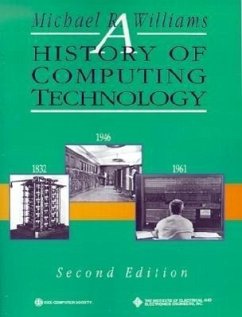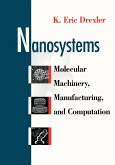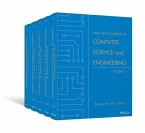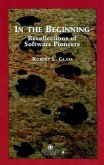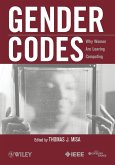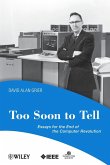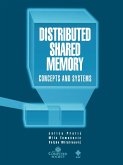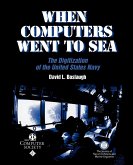Michael R Williams
A History of Computing Technology
Michael R Williams
A History of Computing Technology
- Broschiertes Buch
- Merkliste
- Auf die Merkliste
- Bewerten Bewerten
- Teilen
- Produkt teilen
- Produkterinnerung
- Produkterinnerung
This revised edition of the popular reference and textbook outlines the historical developments in computing technology. It explains and describes historical aspects of calculation with an emphasis on the physical devices used in different times to aid people in their attempts at automating the process of arithmetic.
Andere Kunden interessierten sich auch für
![Nanosystems Nanosystems]() K Eric DrexlerNanosystems75,99 €
K Eric DrexlerNanosystems75,99 €![Wiley Encyclopedia of Computer Science and Engineering, 5 Volume Set Wiley Encyclopedia of Computer Science and Engineering, 5 Volume Set]() Wiley Encyclopedia of Computer Science and Engineering, 5 Volume Set2.619,99 €
Wiley Encyclopedia of Computer Science and Engineering, 5 Volume Set2.619,99 €![In the Beginning In the Beginning]() Robert L GlassIn the Beginning112,99 €
Robert L GlassIn the Beginning112,99 €![Gender Codes Gender Codes]() Gender Codes46,99 €
Gender Codes46,99 €![Too Soon to Tell Too Soon to Tell]() David A GrierToo Soon to Tell50,99 €
David A GrierToo Soon to Tell50,99 €![Distributed Shared Memory Distributed Shared Memory]() Jelica ProticDistributed Shared Memory158,99 €
Jelica ProticDistributed Shared Memory158,99 €![When Computers Went to Sea When Computers Went to Sea]() David L BoslaughWhen Computers Went to Sea98,99 €
David L BoslaughWhen Computers Went to Sea98,99 €-
-
-
This revised edition of the popular reference and textbook outlines the historical developments in computing technology. It explains and describes historical aspects of calculation with an emphasis on the physical devices used in different times to aid people in their attempts at automating the process of arithmetic.
Hinweis: Dieser Artikel kann nur an eine deutsche Lieferadresse ausgeliefert werden.
Hinweis: Dieser Artikel kann nur an eine deutsche Lieferadresse ausgeliefert werden.
Produktdetails
- Produktdetails
- Verlag: Wiley
- 2nd edition
- Seitenzahl: 444
- Erscheinungstermin: 10. April 1997
- Englisch
- Abmessung: 249mm x 189mm x 24mm
- Gewicht: 794g
- ISBN-13: 9780818677397
- ISBN-10: 0818677392
- Artikelnr.: 22036971
- Herstellerkennzeichnung
- Libri GmbH
- Europaallee 1
- 36244 Bad Hersfeld
- gpsr@libri.de
- Verlag: Wiley
- 2nd edition
- Seitenzahl: 444
- Erscheinungstermin: 10. April 1997
- Englisch
- Abmessung: 249mm x 189mm x 24mm
- Gewicht: 794g
- ISBN-13: 9780818677397
- ISBN-10: 0818677392
- Artikelnr.: 22036971
- Herstellerkennzeichnung
- Libri GmbH
- Europaallee 1
- 36244 Bad Hersfeld
- gpsr@libri.de
Michael R. Williams is the author of A History of Computing Technology, 2nd Edition, published by Wiley.
Chapter 1: In the Beginning.
1.1 Numeration.
1.2 Written Number Systems.
1.2.1 The Additive Number System.
1.2.2 The Positional System.
1.3 The Egyptians.
1.4 The Greeks.
1.5 The European Number System.
1.6 The Far East.
1.7 Other Forms of Notation.
1.7.1 Knotted Cords for Record Keeping.
1.7.2 Tally Sticks.
1.7.3 Other Methods of Numerical Notation.
Further Reading.
Endnotes for Chapter 1.
Chapter 2: Early Aids to Calculation.
2.1 Introduction.
2.2 Finger Reckoning.
2.3 The Abacus.
2.4 The Quadrant.
2.5 Two Legged Instruments.
2.5.1 The Proportional Compass.
2.5.2 The Sector.
2.6 Napier's Bones.
2.6.1 Napier and His Bones.
2.6.2 Gaspard Schott and Athanasius Kircher.
2.6.3 Early Versions of Napier's Bones.
2.6.4 Genaille--Lucas Rulers.
2.7 Logarithms.
2.8 The Slide Rule.
Further Reading.
Endnotes for Chapter 2.
Chapter 3: Mechanical Calculating Machines.
3.1 Introduction.
3.2 Wilhelm Schickard (1592-1635).
3.3 Blaise Pascal (1623-1662).
3.4 Gottfried Wilhelm Leibniz (1646-1716).
3.5 Samuel Morland (1625-1695).
3.6 Rene Grillet.
3.7 Commercially Produced Machines.
3.7.1 The Thomas Arithmometer.
3.7.2 The Baldwin-Odhner Machines.
3.7.3 Key-Driven Machines.
Further Reading.
Endnotes for Chapter 3.
Chapter 4: The Babbage Machines.
4.1 Charles Babbage (1791-1871).
4.2 The Need for Accuracy.
4.3 The Method of Differences.
4.4 Babbage's Difference Engine.
4.5 The Scheutz Difference Engine.
4.6 Other Attempts At Difference Engines.
4.7 Babbage's Analytical Engine.
4.8 Percy Ludgate (1883-1922).
Further Reading.
Endnotes for Chapter 4.
Chapter 5: The Analog Animals.
5.1 Introduction.
5.2 The Astrolabe.
5.3 The Antikythera Device.
5.4 Tide Predictors.
5.5 Differential Analyzers.
Further Reading.
Endnotes for Chapter 5.
Chapter 6: The Mechanical Monsters.
6.1 Introduction.
6.2 The Zuse Machines.
6.2.1 Konrad Zuse.
6.2.2 The Z1.
6.2.3 The Z2.
6.2.4 The Z3.
6.2.5 The Z4.
6.2.6 The Other Zuse Machines.
6.3 The Bell Relay Computers.
6.3.1 The Situation.
6.3.2 The Complex Number Calculator.
6.3.3 The Relay Interpolator.
6.3.4 The Models III and IV.
6.3.5 The Model V (The Twin Machine).
6.3.6 The Model VI.
6.4 The Harvard Machines of Howard Aiken.
6.4.1 Introduction.
6.4.2 The Harvard Mark I.
6.4.3 The Harvard Mark II.
6.4.4 The Harvard Mark III and Mark IV.
6.5 The IBM Calculators.
6.5.1 The Punched Card Systems.
6.5.2 The Large IBM Calculators.
6.5.3 The Selective Sequence Electronic Calculator (SSEC).
Further Reading.
Chapter 7: The Electronic Revolution.
7.1 Introduction.
7.2 John Atanasoff, Clifford Berry, & the ABC.
7.3 The ENIAC.
7.3.1 Introduction.
7.3.2 The Place and the Problem.
7.3.3 The People.
7.3.4 The Machine.
7.4The Colossus Machines.
7.4.1 The Enigma.
7.4.2 Alan Turing (1912-1954).
7.4.3 The Robinsons.
7.4.4 The Colossus.
Further Reading.
Endnotes for Chapter 7.
Chapter 8: The First Stored Program Electronic Computers.
8.1 The Genesis of the Ideas.
8.2 Computer Memory Systems.
8.2.1 Introduction.
8.2.2 Thermal Memories.
8.2.3 Mechanical Memories.
8.2.4 Delay Line Systems.
8.2.5 Electrostatic Storage Mechanisms.
8.2.6 Rotating Magnetic Memories.
8.2.7 Static Magnetic Memories.
8.3 The British Scene.
8.3.1 Introduction.
8.3.2 The Manchester Machine.
8.3.3 The Cambridge Machine-EDSAC.
8.3.4 The NPL Pilot Ace.
8.4 The American Scene.
8.4.1 The American Background.
8.4.2 The Electronic Discrete Variable Arithmetic Computer (EDVAC).
8.4.3 The Institute for Advanced Study Machine (IAS).
8.4.4 The Eckert/Mauchly Machines, BINAC and UNIVAC.
8.4.5 The SEAC and SWAC Machines.
8.4.6 Project Whirlwind.
Further Reading.
Endnotes for Chapter 8.
Chapter 9: Later Developments.
9.1 Introduction.
9.2 The Early Machines of IBM.
9.2.1 The NORC.
9.2.2 The 700-7000 Series Machines.
9.3 Early Super Computers.
9.3.1 The Stretch.
9.3.2 The LARC.
9.3.3 The Ferranti Atlas.
9.4 The IBM/360 Series of Machines.
Further Reading.
Endnotes for Chapter 9.
Appendix.
Index.
1.1 Numeration.
1.2 Written Number Systems.
1.2.1 The Additive Number System.
1.2.2 The Positional System.
1.3 The Egyptians.
1.4 The Greeks.
1.5 The European Number System.
1.6 The Far East.
1.7 Other Forms of Notation.
1.7.1 Knotted Cords for Record Keeping.
1.7.2 Tally Sticks.
1.7.3 Other Methods of Numerical Notation.
Further Reading.
Endnotes for Chapter 1.
Chapter 2: Early Aids to Calculation.
2.1 Introduction.
2.2 Finger Reckoning.
2.3 The Abacus.
2.4 The Quadrant.
2.5 Two Legged Instruments.
2.5.1 The Proportional Compass.
2.5.2 The Sector.
2.6 Napier's Bones.
2.6.1 Napier and His Bones.
2.6.2 Gaspard Schott and Athanasius Kircher.
2.6.3 Early Versions of Napier's Bones.
2.6.4 Genaille--Lucas Rulers.
2.7 Logarithms.
2.8 The Slide Rule.
Further Reading.
Endnotes for Chapter 2.
Chapter 3: Mechanical Calculating Machines.
3.1 Introduction.
3.2 Wilhelm Schickard (1592-1635).
3.3 Blaise Pascal (1623-1662).
3.4 Gottfried Wilhelm Leibniz (1646-1716).
3.5 Samuel Morland (1625-1695).
3.6 Rene Grillet.
3.7 Commercially Produced Machines.
3.7.1 The Thomas Arithmometer.
3.7.2 The Baldwin-Odhner Machines.
3.7.3 Key-Driven Machines.
Further Reading.
Endnotes for Chapter 3.
Chapter 4: The Babbage Machines.
4.1 Charles Babbage (1791-1871).
4.2 The Need for Accuracy.
4.3 The Method of Differences.
4.4 Babbage's Difference Engine.
4.5 The Scheutz Difference Engine.
4.6 Other Attempts At Difference Engines.
4.7 Babbage's Analytical Engine.
4.8 Percy Ludgate (1883-1922).
Further Reading.
Endnotes for Chapter 4.
Chapter 5: The Analog Animals.
5.1 Introduction.
5.2 The Astrolabe.
5.3 The Antikythera Device.
5.4 Tide Predictors.
5.5 Differential Analyzers.
Further Reading.
Endnotes for Chapter 5.
Chapter 6: The Mechanical Monsters.
6.1 Introduction.
6.2 The Zuse Machines.
6.2.1 Konrad Zuse.
6.2.2 The Z1.
6.2.3 The Z2.
6.2.4 The Z3.
6.2.5 The Z4.
6.2.6 The Other Zuse Machines.
6.3 The Bell Relay Computers.
6.3.1 The Situation.
6.3.2 The Complex Number Calculator.
6.3.3 The Relay Interpolator.
6.3.4 The Models III and IV.
6.3.5 The Model V (The Twin Machine).
6.3.6 The Model VI.
6.4 The Harvard Machines of Howard Aiken.
6.4.1 Introduction.
6.4.2 The Harvard Mark I.
6.4.3 The Harvard Mark II.
6.4.4 The Harvard Mark III and Mark IV.
6.5 The IBM Calculators.
6.5.1 The Punched Card Systems.
6.5.2 The Large IBM Calculators.
6.5.3 The Selective Sequence Electronic Calculator (SSEC).
Further Reading.
Chapter 7: The Electronic Revolution.
7.1 Introduction.
7.2 John Atanasoff, Clifford Berry, & the ABC.
7.3 The ENIAC.
7.3.1 Introduction.
7.3.2 The Place and the Problem.
7.3.3 The People.
7.3.4 The Machine.
7.4The Colossus Machines.
7.4.1 The Enigma.
7.4.2 Alan Turing (1912-1954).
7.4.3 The Robinsons.
7.4.4 The Colossus.
Further Reading.
Endnotes for Chapter 7.
Chapter 8: The First Stored Program Electronic Computers.
8.1 The Genesis of the Ideas.
8.2 Computer Memory Systems.
8.2.1 Introduction.
8.2.2 Thermal Memories.
8.2.3 Mechanical Memories.
8.2.4 Delay Line Systems.
8.2.5 Electrostatic Storage Mechanisms.
8.2.6 Rotating Magnetic Memories.
8.2.7 Static Magnetic Memories.
8.3 The British Scene.
8.3.1 Introduction.
8.3.2 The Manchester Machine.
8.3.3 The Cambridge Machine-EDSAC.
8.3.4 The NPL Pilot Ace.
8.4 The American Scene.
8.4.1 The American Background.
8.4.2 The Electronic Discrete Variable Arithmetic Computer (EDVAC).
8.4.3 The Institute for Advanced Study Machine (IAS).
8.4.4 The Eckert/Mauchly Machines, BINAC and UNIVAC.
8.4.5 The SEAC and SWAC Machines.
8.4.6 Project Whirlwind.
Further Reading.
Endnotes for Chapter 8.
Chapter 9: Later Developments.
9.1 Introduction.
9.2 The Early Machines of IBM.
9.2.1 The NORC.
9.2.2 The 700-7000 Series Machines.
9.3 Early Super Computers.
9.3.1 The Stretch.
9.3.2 The LARC.
9.3.3 The Ferranti Atlas.
9.4 The IBM/360 Series of Machines.
Further Reading.
Endnotes for Chapter 9.
Appendix.
Index.
Chapter 1: In the Beginning.
1.1 Numeration.
1.2 Written Number Systems.
1.2.1 The Additive Number System.
1.2.2 The Positional System.
1.3 The Egyptians.
1.4 The Greeks.
1.5 The European Number System.
1.6 The Far East.
1.7 Other Forms of Notation.
1.7.1 Knotted Cords for Record Keeping.
1.7.2 Tally Sticks.
1.7.3 Other Methods of Numerical Notation.
Further Reading.
Endnotes for Chapter 1.
Chapter 2: Early Aids to Calculation.
2.1 Introduction.
2.2 Finger Reckoning.
2.3 The Abacus.
2.4 The Quadrant.
2.5 Two Legged Instruments.
2.5.1 The Proportional Compass.
2.5.2 The Sector.
2.6 Napier's Bones.
2.6.1 Napier and His Bones.
2.6.2 Gaspard Schott and Athanasius Kircher.
2.6.3 Early Versions of Napier's Bones.
2.6.4 Genaille--Lucas Rulers.
2.7 Logarithms.
2.8 The Slide Rule.
Further Reading.
Endnotes for Chapter 2.
Chapter 3: Mechanical Calculating Machines.
3.1 Introduction.
3.2 Wilhelm Schickard (1592-1635).
3.3 Blaise Pascal (1623-1662).
3.4 Gottfried Wilhelm Leibniz (1646-1716).
3.5 Samuel Morland (1625-1695).
3.6 Rene Grillet.
3.7 Commercially Produced Machines.
3.7.1 The Thomas Arithmometer.
3.7.2 The Baldwin-Odhner Machines.
3.7.3 Key-Driven Machines.
Further Reading.
Endnotes for Chapter 3.
Chapter 4: The Babbage Machines.
4.1 Charles Babbage (1791-1871).
4.2 The Need for Accuracy.
4.3 The Method of Differences.
4.4 Babbage's Difference Engine.
4.5 The Scheutz Difference Engine.
4.6 Other Attempts At Difference Engines.
4.7 Babbage's Analytical Engine.
4.8 Percy Ludgate (1883-1922).
Further Reading.
Endnotes for Chapter 4.
Chapter 5: The Analog Animals.
5.1 Introduction.
5.2 The Astrolabe.
5.3 The Antikythera Device.
5.4 Tide Predictors.
5.5 Differential Analyzers.
Further Reading.
Endnotes for Chapter 5.
Chapter 6: The Mechanical Monsters.
6.1 Introduction.
6.2 The Zuse Machines.
6.2.1 Konrad Zuse.
6.2.2 The Z1.
6.2.3 The Z2.
6.2.4 The Z3.
6.2.5 The Z4.
6.2.6 The Other Zuse Machines.
6.3 The Bell Relay Computers.
6.3.1 The Situation.
6.3.2 The Complex Number Calculator.
6.3.3 The Relay Interpolator.
6.3.4 The Models III and IV.
6.3.5 The Model V (The Twin Machine).
6.3.6 The Model VI.
6.4 The Harvard Machines of Howard Aiken.
6.4.1 Introduction.
6.4.2 The Harvard Mark I.
6.4.3 The Harvard Mark II.
6.4.4 The Harvard Mark III and Mark IV.
6.5 The IBM Calculators.
6.5.1 The Punched Card Systems.
6.5.2 The Large IBM Calculators.
6.5.3 The Selective Sequence Electronic Calculator (SSEC).
Further Reading.
Chapter 7: The Electronic Revolution.
7.1 Introduction.
7.2 John Atanasoff, Clifford Berry, & the ABC.
7.3 The ENIAC.
7.3.1 Introduction.
7.3.2 The Place and the Problem.
7.3.3 The People.
7.3.4 The Machine.
7.4The Colossus Machines.
7.4.1 The Enigma.
7.4.2 Alan Turing (1912-1954).
7.4.3 The Robinsons.
7.4.4 The Colossus.
Further Reading.
Endnotes for Chapter 7.
Chapter 8: The First Stored Program Electronic Computers.
8.1 The Genesis of the Ideas.
8.2 Computer Memory Systems.
8.2.1 Introduction.
8.2.2 Thermal Memories.
8.2.3 Mechanical Memories.
8.2.4 Delay Line Systems.
8.2.5 Electrostatic Storage Mechanisms.
8.2.6 Rotating Magnetic Memories.
8.2.7 Static Magnetic Memories.
8.3 The British Scene.
8.3.1 Introduction.
8.3.2 The Manchester Machine.
8.3.3 The Cambridge Machine-EDSAC.
8.3.4 The NPL Pilot Ace.
8.4 The American Scene.
8.4.1 The American Background.
8.4.2 The Electronic Discrete Variable Arithmetic Computer (EDVAC).
8.4.3 The Institute for Advanced Study Machine (IAS).
8.4.4 The Eckert/Mauchly Machines, BINAC and UNIVAC.
8.4.5 The SEAC and SWAC Machines.
8.4.6 Project Whirlwind.
Further Reading.
Endnotes for Chapter 8.
Chapter 9: Later Developments.
9.1 Introduction.
9.2 The Early Machines of IBM.
9.2.1 The NORC.
9.2.2 The 700-7000 Series Machines.
9.3 Early Super Computers.
9.3.1 The Stretch.
9.3.2 The LARC.
9.3.3 The Ferranti Atlas.
9.4 The IBM/360 Series of Machines.
Further Reading.
Endnotes for Chapter 9.
Appendix.
Index.
1.1 Numeration.
1.2 Written Number Systems.
1.2.1 The Additive Number System.
1.2.2 The Positional System.
1.3 The Egyptians.
1.4 The Greeks.
1.5 The European Number System.
1.6 The Far East.
1.7 Other Forms of Notation.
1.7.1 Knotted Cords for Record Keeping.
1.7.2 Tally Sticks.
1.7.3 Other Methods of Numerical Notation.
Further Reading.
Endnotes for Chapter 1.
Chapter 2: Early Aids to Calculation.
2.1 Introduction.
2.2 Finger Reckoning.
2.3 The Abacus.
2.4 The Quadrant.
2.5 Two Legged Instruments.
2.5.1 The Proportional Compass.
2.5.2 The Sector.
2.6 Napier's Bones.
2.6.1 Napier and His Bones.
2.6.2 Gaspard Schott and Athanasius Kircher.
2.6.3 Early Versions of Napier's Bones.
2.6.4 Genaille--Lucas Rulers.
2.7 Logarithms.
2.8 The Slide Rule.
Further Reading.
Endnotes for Chapter 2.
Chapter 3: Mechanical Calculating Machines.
3.1 Introduction.
3.2 Wilhelm Schickard (1592-1635).
3.3 Blaise Pascal (1623-1662).
3.4 Gottfried Wilhelm Leibniz (1646-1716).
3.5 Samuel Morland (1625-1695).
3.6 Rene Grillet.
3.7 Commercially Produced Machines.
3.7.1 The Thomas Arithmometer.
3.7.2 The Baldwin-Odhner Machines.
3.7.3 Key-Driven Machines.
Further Reading.
Endnotes for Chapter 3.
Chapter 4: The Babbage Machines.
4.1 Charles Babbage (1791-1871).
4.2 The Need for Accuracy.
4.3 The Method of Differences.
4.4 Babbage's Difference Engine.
4.5 The Scheutz Difference Engine.
4.6 Other Attempts At Difference Engines.
4.7 Babbage's Analytical Engine.
4.8 Percy Ludgate (1883-1922).
Further Reading.
Endnotes for Chapter 4.
Chapter 5: The Analog Animals.
5.1 Introduction.
5.2 The Astrolabe.
5.3 The Antikythera Device.
5.4 Tide Predictors.
5.5 Differential Analyzers.
Further Reading.
Endnotes for Chapter 5.
Chapter 6: The Mechanical Monsters.
6.1 Introduction.
6.2 The Zuse Machines.
6.2.1 Konrad Zuse.
6.2.2 The Z1.
6.2.3 The Z2.
6.2.4 The Z3.
6.2.5 The Z4.
6.2.6 The Other Zuse Machines.
6.3 The Bell Relay Computers.
6.3.1 The Situation.
6.3.2 The Complex Number Calculator.
6.3.3 The Relay Interpolator.
6.3.4 The Models III and IV.
6.3.5 The Model V (The Twin Machine).
6.3.6 The Model VI.
6.4 The Harvard Machines of Howard Aiken.
6.4.1 Introduction.
6.4.2 The Harvard Mark I.
6.4.3 The Harvard Mark II.
6.4.4 The Harvard Mark III and Mark IV.
6.5 The IBM Calculators.
6.5.1 The Punched Card Systems.
6.5.2 The Large IBM Calculators.
6.5.3 The Selective Sequence Electronic Calculator (SSEC).
Further Reading.
Chapter 7: The Electronic Revolution.
7.1 Introduction.
7.2 John Atanasoff, Clifford Berry, & the ABC.
7.3 The ENIAC.
7.3.1 Introduction.
7.3.2 The Place and the Problem.
7.3.3 The People.
7.3.4 The Machine.
7.4The Colossus Machines.
7.4.1 The Enigma.
7.4.2 Alan Turing (1912-1954).
7.4.3 The Robinsons.
7.4.4 The Colossus.
Further Reading.
Endnotes for Chapter 7.
Chapter 8: The First Stored Program Electronic Computers.
8.1 The Genesis of the Ideas.
8.2 Computer Memory Systems.
8.2.1 Introduction.
8.2.2 Thermal Memories.
8.2.3 Mechanical Memories.
8.2.4 Delay Line Systems.
8.2.5 Electrostatic Storage Mechanisms.
8.2.6 Rotating Magnetic Memories.
8.2.7 Static Magnetic Memories.
8.3 The British Scene.
8.3.1 Introduction.
8.3.2 The Manchester Machine.
8.3.3 The Cambridge Machine-EDSAC.
8.3.4 The NPL Pilot Ace.
8.4 The American Scene.
8.4.1 The American Background.
8.4.2 The Electronic Discrete Variable Arithmetic Computer (EDVAC).
8.4.3 The Institute for Advanced Study Machine (IAS).
8.4.4 The Eckert/Mauchly Machines, BINAC and UNIVAC.
8.4.5 The SEAC and SWAC Machines.
8.4.6 Project Whirlwind.
Further Reading.
Endnotes for Chapter 8.
Chapter 9: Later Developments.
9.1 Introduction.
9.2 The Early Machines of IBM.
9.2.1 The NORC.
9.2.2 The 700-7000 Series Machines.
9.3 Early Super Computers.
9.3.1 The Stretch.
9.3.2 The LARC.
9.3.3 The Ferranti Atlas.
9.4 The IBM/360 Series of Machines.
Further Reading.
Endnotes for Chapter 9.
Appendix.
Index.

